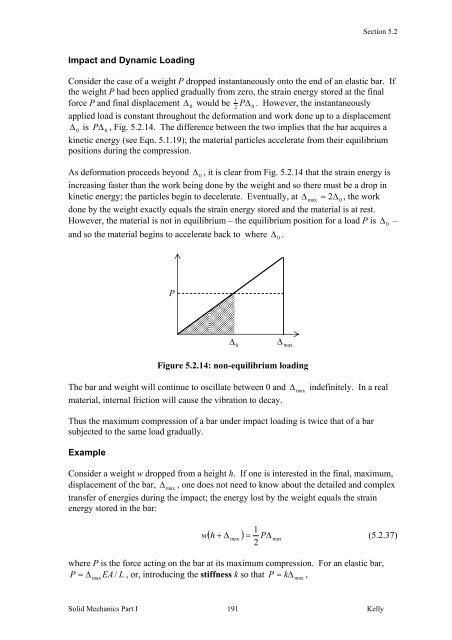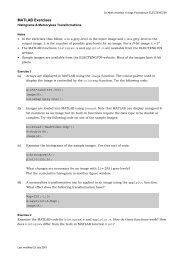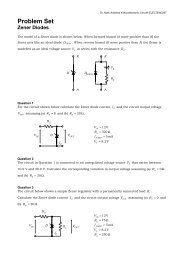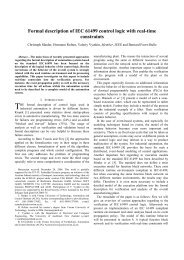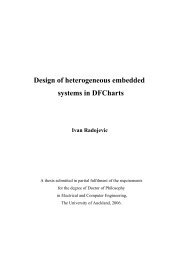5.2 Elastic Strain Energy
5.2 Elastic Strain Energy
5.2 Elastic Strain Energy
You also want an ePaper? Increase the reach of your titles
YUMPU automatically turns print PDFs into web optimized ePapers that Google loves.
Impact and Dynamic Loading<br />
Section <strong>5.2</strong><br />
Consider the case of a weight P dropped instantaneously onto the end of an elastic bar. If<br />
the weight P had been applied gradually from zero, the strain energy stored at the final<br />
1 force P and final displacement Δ 0 would be 2 P Δ 0 . However, the instantaneously<br />
applied load is constant throughout the deformation and work done up to a displacement<br />
Δ 0 is P Δ 0 , Fig. <strong>5.2</strong>.14. The difference between the two implies that the bar acquires a<br />
kinetic energy (see Eqn. 5.1.19); the material particles accelerate from their equilibrium<br />
positions during the compression.<br />
As deformation proceeds beyond Δ 0 , it is clear from Fig. <strong>5.2</strong>.14 that the strain energy is<br />
increasing faster than the work being done by the weight and so there must be a drop in<br />
kinetic energy; the particles begin to decelerate. Eventually, at Δ max = 2Δ 0 , the work<br />
done by the weight exactly equals the strain energy stored and the material is at rest.<br />
However, the material is not in equilibrium – the equilibrium position for a load P is Δ 0 –<br />
and so the material begins to accelerate back to where Δ 0 .<br />
Figure <strong>5.2</strong>.14: non-equilibrium loading<br />
The bar and weight will continue to oscillate between 0 and Δ max indefinitely. In a real<br />
material, internal friction will cause the vibration to decay.<br />
Thus the maximum compression of a bar under impact loading is twice that of a bar<br />
subjected to the same load gradually.<br />
Example<br />
P<br />
Δ Δ<br />
0<br />
max<br />
Consider a weight w dropped from a height h. If one is interested in the final, maximum,<br />
displacement of the bar, Δ max , one does not need to know about the detailed and complex<br />
transfer of energies during the impact; the energy lost by the weight equals the strain<br />
energy stored in the bar:<br />
1<br />
w ( h + Δ max ) = PΔ<br />
max<br />
(<strong>5.2</strong>.37)<br />
2<br />
where P is the force acting on the bar at its maximum compression. For an elastic bar,<br />
P Δ EA/<br />
L<br />
P = kΔ<br />
,<br />
= max , or, introducing the stiffness k so that max<br />
Solid Mechanics Part I 191<br />
Kelly


